| 1 | Dumeril’s boa |
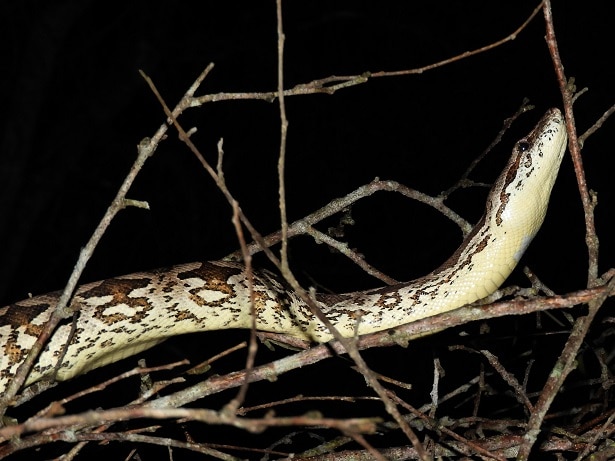
One of two large, crushing boas found on Madagascar. Dumeril’s boa is abundant in the southern half of Madagascar, where they’re most commonly found in dry, crunchy woodlands and more open forests. This is Madagascar’s second longest snake, with an all-time record of 259cm, and an average newborn size of 45cm.
Dumeril’s boas prey mainly on mammals, and large meals are confirmed, such as the southern bamboo lemur. This is a thick, bulky constrictor which stays on the ground for most of the day, waiting in ambush, using its immense camouflage to blend into leaves. They also take shelter in hollow logs on occasion. Young Dumeril’s boas are able to climb trees, before becoming so bulky as adults that the branches are likely to snap.
You can also find this species in caves, including in Madagascar’s Tsimanampesotse National Park, which they turn into a permanent base. Dumeril’s boa is a popular species in captivity worldwide, and has a strange similarity to the boa constrictor, despite the two living halfway around the world from each other.
For years, Dumeril’s boas were exported en masse from Madagascar, and their numbers in the wild are now far lower than originally. Dumeril’s boas are hunted by locals for food and to turn into handbags, and deforestation is rife on Madagascar as well. Fortunately, there’s plenty of captive breeding operations overseas, including in southern England’s Cotswold Wildlife Park. You still have a good chance of bumping into Dumeril’s boa while on holiday, perhaps while touring one of Madagascar’s many cocoa plantations.
| 2 | Common Madagascar cat snake |
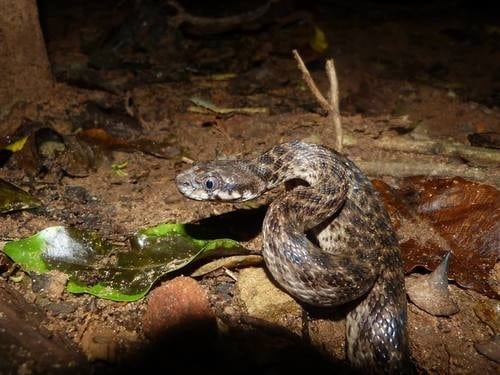
A nimble tree snake found only on Madagascar, which reaches a maximum length of 106cm. This species inhabits every corner of Madagascar, and is part of the 5-member Madagascarophis genus, collectively called the Malagasy cat-eyed snakes, which are found exclusively on Madagascar.
Madagascarophis colubrinus is a branch-loving snake, and is probably the single snake the average Madagascan tourist is most likely to meet. They appear anywhere where trees grow, including woodlands and remote forests, but also public gardens and parks. They usually have blotchy patterns, but their colours vary from yellow to brown to silver.
There’s a great mystery over exactly how venomous the common Madagascan cat snake is. They secrete a venom from their rear fangs, which must be chewed in rather than instantly injected. Such venoms are usually weak, but bites have been reported to cause swelling, pain, blistering and necrosis. Others report that the bite is virtually harmless in humans, and is so weak in its prey (which includes chameleons and hatchling birds) that they have to deploy constriction as a back up.
Deepening the mystery, a 2023 study discovered that Madagascarophis colubrinus venom contains a neurotoxic peptide called macoluxin, which binds to acetylcholine receptors in muscle cells. These are the same receptors that black mamba neurotoxins bind to, in order to cause paralysis and laboured breathing.
| 3 | Madagascan ground boa |
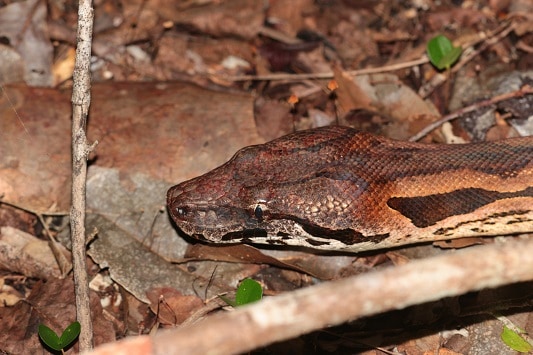
The official longest snake on Madagascar, with a record length of 320cm. This species belongs to the same Acrantophis genus as Dumeril’s boa, but controls the north and northwest, while Dumeril’s boa controls the south.
Like their cousin, Madagascan ground boas live in dry, open woodlands, and their camouflage is just as excellent. Camouflaged eyes are a classic feature of this snake genus, as you can see in the image above – the brown stripe on their face continues right through the eye uninterrupted.
This snake mainly feeds on mammals, such as brown lemurs and Coquerel’s sifakas. In captivity, they happily swallow birds as well. Madagascan ground boas are shy in personality, and mainly stick to the ground. They’re not especially aggressive with humans, and reproduce slowly, laying 2-4 live young after a long gestation period of 4-6 months.
This species also produced the heaviest Madagascan snake yet recorded. “Big George” was measured on July 2nd 2013, and weighed in at 8.2kg, with a length of 270cm. This boa lived in Anjajavy l’Hôtel, Sofia Region, northwest Madagascar, where it had inhabited the grounds for years (since 2004), and was a familiar character to the staff.
| 4 | Tiny night snake |
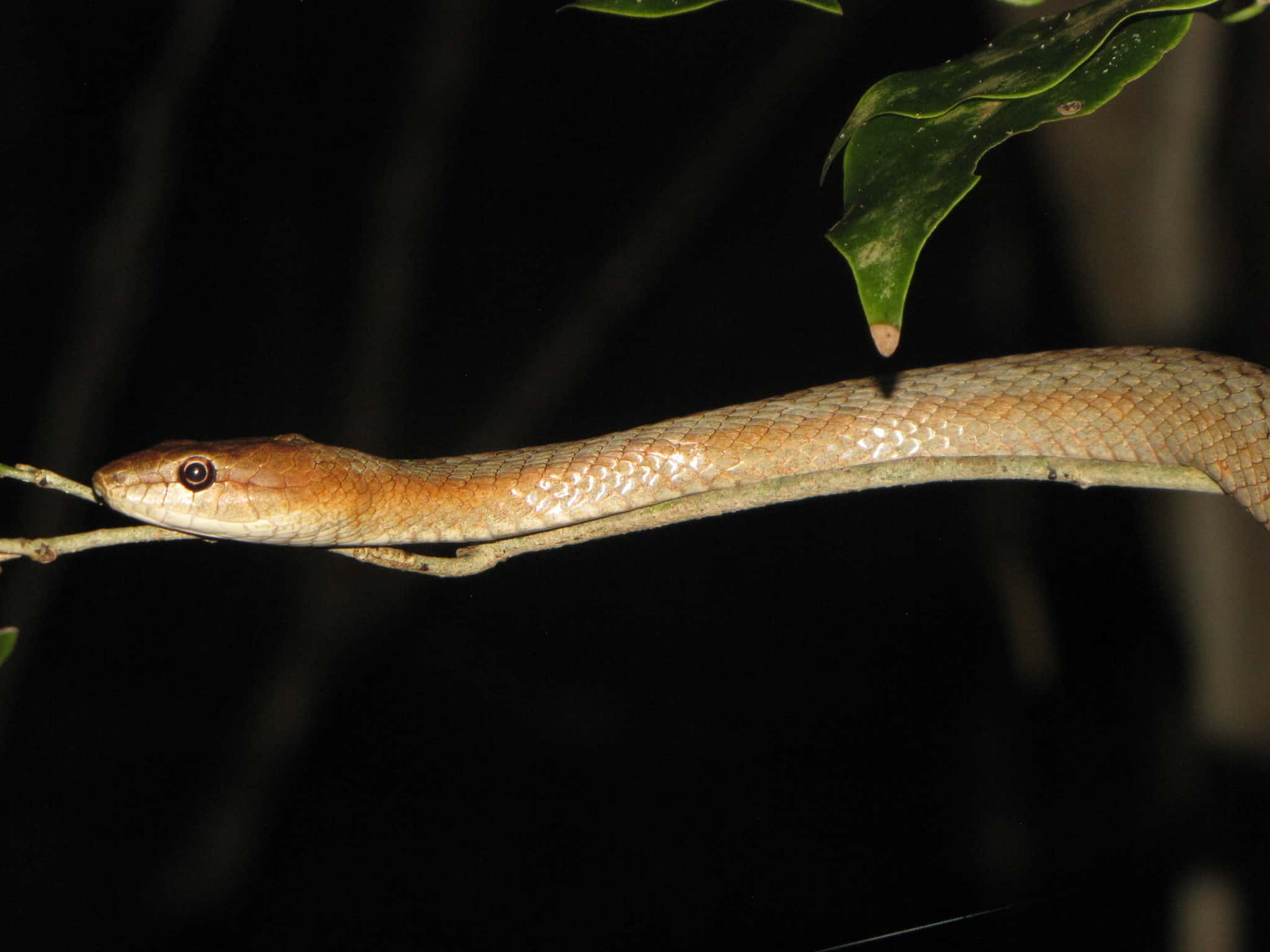
Ithycyphus miniatus, AKA the tiny night snake, is an endemic species which is misleadingly named. Firstly, it actually moves by day. Secondly, they’re not tiny at all, reaching a maximum length of 1.7 metres.
This snake lives only on Madagascar, mainly in the northern half, and splits its time between low branches and the ground. Tiny night snakes vary from reddish-brown to a pale tree branch beige, allowing them to blend perfectly with forested environments. They get darker as the tail approaches, with beige gradually shifting to a darker red.
This species has two detailed bite reports in humans. The first involved a 33 year old man who dislodged the snake’s fangs after 30 seconds, and experienced no symptoms whatsoever. But the second man (aged 42) was worried about the snake’s teeth slashing his fingers open, and left it attached for 60 seconds, during which it chewed nonstop. The man’s finger swelled like a balloon, followed by his hand at the base of the finger, followed later by his middle finger and little finger. Later that evening, the man reported an unusually low appetite.
Scientists have also noticed how the tiny night snake’s prey (which includes panther chameleons) tends to become immobile after being bitten. The verdict: this Madagascan snake has a slight chance of sending a human being to hospital.
| 5 | Giant Madagascan hognose snake |
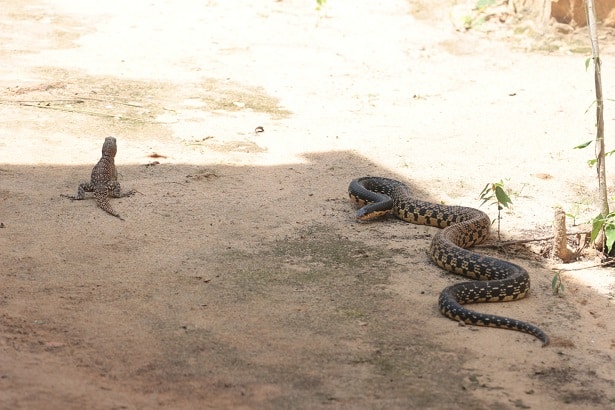
One of Madagascar’s largest snakes, and also one of the most common. The Madagascan hognose snake (Leioheterodon madagascariensis) is found all across island, though is more abundant in the northern half. Locals dub it the Menarana, while Dutch people call it Madagaskar haakneusslang. Madagascar hognose snakes are moderately venomous, and reach a maximum of 1.8 metres.
Unlike the two large boas on Madagascar, this species has barely declined at all. Madagascan hognose snakes are flexible, and can be found slithering through villages or even on the outskirts of cities. Dry plains and woodlands are equally acceptable to them. They spend most of their time on the ground, climbing low branches very occasionally.
The Madagascar hognose snake is one of the most multi-skilled species around. They wrestle each other for mating rights, and defend their egg nests viciously. If they meet humans, they can either flee, or perform an elaborate bluff strike. But Madagascar hognose snakes also have a decently strong venom, as shown in a 2014 case report, where the victim experienced a swollen hand and lower arm lasting for 5 days.
This is one of the most confident Madagascan snakes, slithering around happily and making no attempt to disguise themselves. Leioheterodon madagascariensis is black and cream coloured, but the exact proportions vary. In some, the colours alternate in evenly spaced checkers, while others have a fully black body with a pale cream belly.
| 6 | Pencil snake |
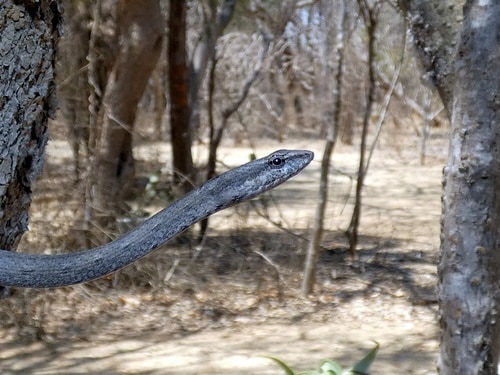
Of all Madagascan snakes, this species may have the greatest camouflage against crunchy forest floors. The pencil snake (Mimophis mahfalensis) is mostly harmless to humans, and looks like a piece of tree bark which somehow started slithering.
This species reaches 75cm at the maximum, and almost never bites humans. They mainly stick to the ground, weaving through layers of fallen branches and accumulated debris, though they sometimes climb branches. Pencil snakes are unique in Madagascar for appearing in very high densities, and are infamous for hanging out in bushes at night in large numbers.
Pencil snakes are common in Madagascar, inhabiting virtually the entire country except the humid east coast. Though they prey on frogs and others snakes, they’re particularly fond of chameleons, including southern carpet chameleons, canopy chameleons and Labord’s chameleons.
Pencil snakes don’t shy away from human-occupied zones either. Dry woods, thorn forests and savannahs are some of their favourite natural habitats. This snake has a mild venom, which it chews slowly into prey to disable them. In humans, this causes little more than itching and a mild throbbing pain.
Originally, Mimophis mahfalensis covered the whole of Madagascar. In 2017, the northern enclaves were split into a new species: Mimophis occultus. These are the only two members of the Mimophis genus.
| 7 | Madagascan tree boa |
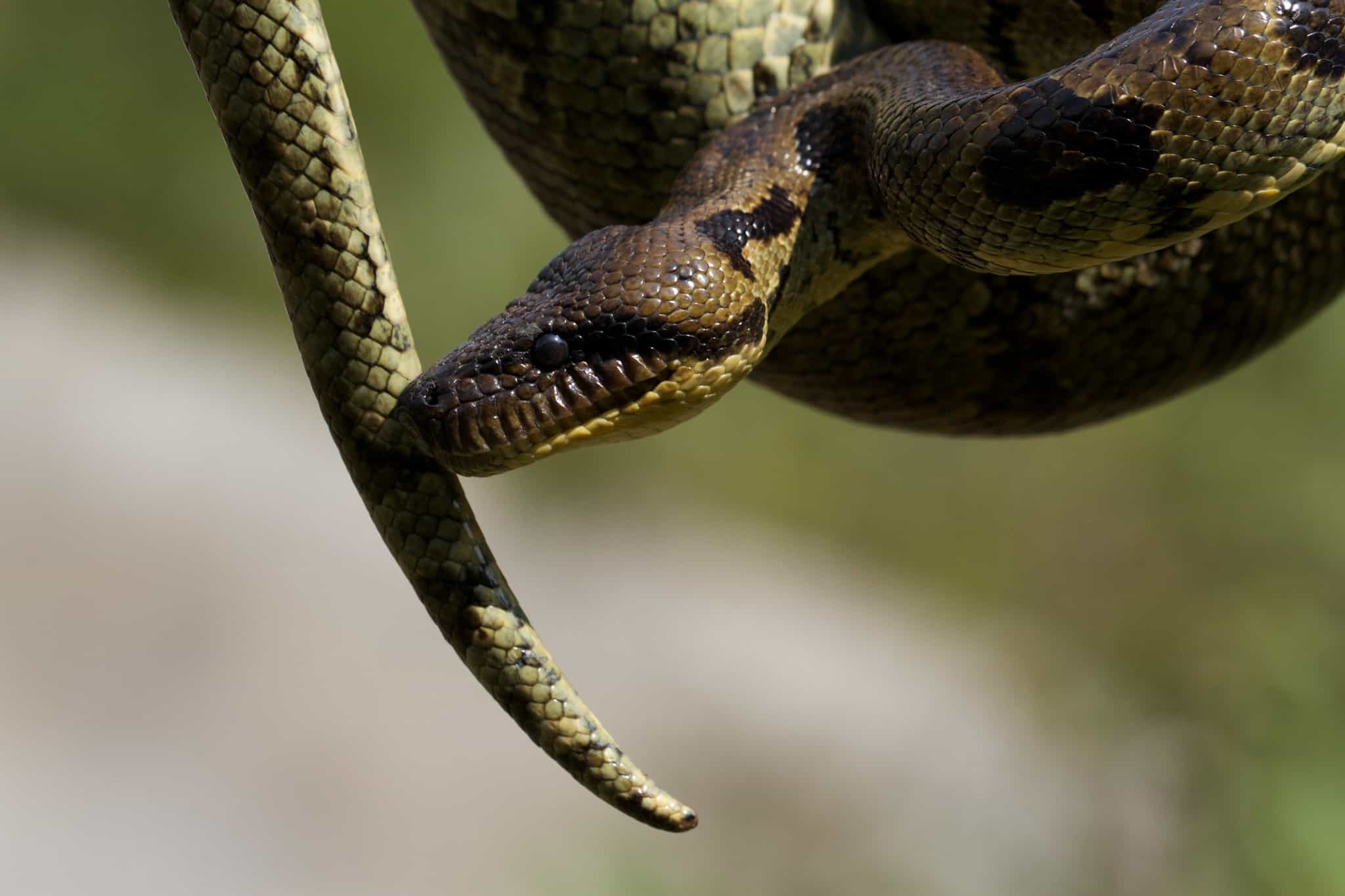
Another boa species, but unlike the two bulky ground boas, this species belongs to a different genus: Sanzinia, of which it’s one of two members. With an average of 122-153cm, and a record of 213cm, this is the shortest of the three boas on our list.
Madagascan tree boas (Sanzinia madagascariensis) mainly live in Madagascar’s north, northwest and east. The name is misleading, as this species splits its time evenly between branches and the forest floor. This is a nocturnal species, which rests on branches during the day, before waking up, dropping to the ground, and starting their nightlong quest for mammals (their main prey).
Madagascan tree boas are common in forests, but also villages, where they take advantage of the legions of introduced black rats. During sunny weather, Madagascan tree boas form a compact ball at the junction of a branch, in order to bask in the warmth.
Madagascan tree boas might be short, but they have an advantage over their neighbours: heat-seeking pits in their face. These grant them infrared vision at night, a power which Dumeril’s boas and Madagascan ground boas lack. You can recognise this species by hourglass or flower-shaped markings, bordered by snowy white patches.
When pregnant, female Madagascan tree boas grow steadily darker, in order to absorb more warmth for their developing young. These arrive in batches of up to 12, and measure 38cm on day 1.
| 8 | Lateral water snake |
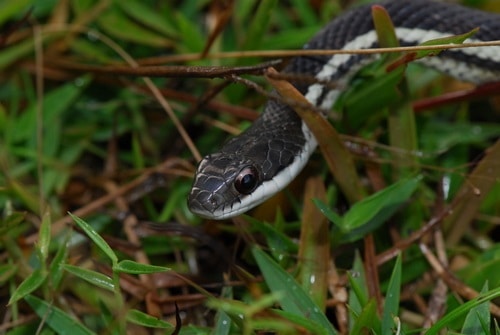
This species is effectively Madagascar’s garter snake equivalent. It’s a medium length snake at up to 90cm, and preys mainly on amphibians. It’s mainly ground-dwelling, but spends a large portion of time in small streams swimming peacefully. They even look similar, with a thin head and parallel beige stripes on each flank.
The lateral watersnake (Thamnosophis lateralis) is an extremely common species in Madagascar, popping up in rainforests, rice fields, grasslands and secondary forests alike. Like US garter snakes, lateral watersnakes have the rare skill of eating poisonous frogs, such as Madagascar’s golden mantella. This has bright orange colours to warn predators of its danger, and is reported to taste disgusting thanks to toxic alkaloids in their skin. Thamnosophis lateralis couldn’t care less, and can eat them anyway, as spotted in 2007.
Though small and humble, lateral watersnakes have a nervous temperament, and will bite humans readily if agitated. Their first defensive display is to flatten their necks, making themselves appear larger. Lateral watersnakes have white skin, which becomes visible through their black scales during this flattening. Some individuals also have vivid electric blue patches visible.
| 9 | Slender smooth snake |
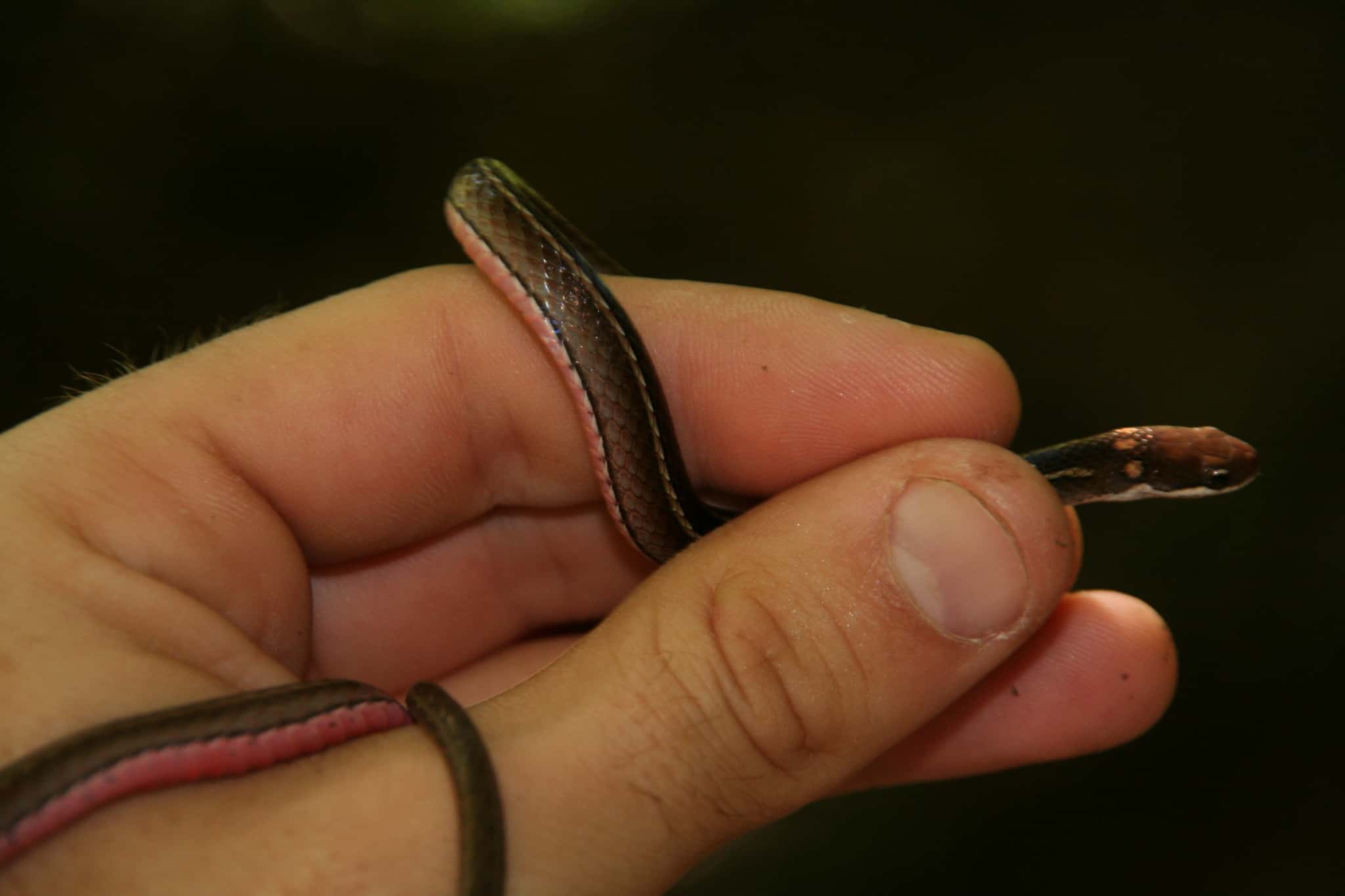
The Liopholidophis snake genus has 8 members, all found exclusively in Madagascar, and all shy and harmless. Slender smooth snakes (Liopholidophis rhadinaea) are particularly recognisable, due to their bright pink bellies the colour of candy floss.
Slender smooth snakes live in dense forests with a closed canopy, making them one of Madagascar’s harder snakes to find. They have very complex patterns, with black lines, beige stripes, a parched brown head, and a creamy chin intermingling. They’re completely harmless to scoop up in your hands and admire, if you can find them.
This Madagascan snake has the power of “tonic immobility“: when snakes instantly paralyse themselves to convince a hungry predator that they’re dead. This is usually activated immediately after touch. In the Liopholidophis genus, slender smooth snakes are the only one known to go completely still like this.
Another special feature of Liopholidophis rhadinaea is an extremely large gender size discrepancy. The record length in males is 74.9cm, already pretty modest, but in females, the record is just 42.4cm. Much of this is down to the tail, which comprises 37-43% of total body length in males versus 24-27% in females. This tail itself is another record, being one of the longest of any snake.
If you’re a typical tourist in Madagascar, exploring established trails, your chances of meeting this species are barely one in a hundred (probably less).
| 10 | Bernier’s striped snake |
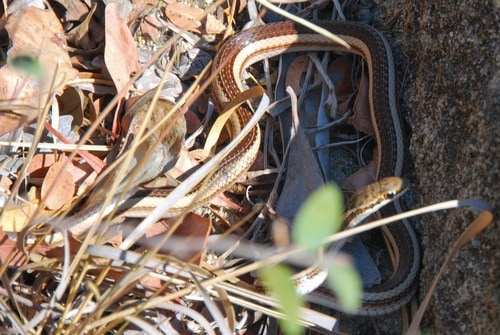
One of Madagascar’s fastest-moving snakes. Bernier’s striped snake is an energetic species which zooms along, raises its neck, and scans the horizon keenly for prey. This is a moderate length species, with an average of 70-90cm and an absolute maximum of 117cm.
This species is found in almost all of Madagascar, from north to south. Bernier’s striped snake (Dromicodryas bernieri) preys almost exclusively on lizards, with the occasional frog being ingested such as the native Douliot’s bright-eyed frog.
If possible, this snake prefers to move in the midst of dry grass, strewn with fallen twigs and branches. Their striped patterns are perfect for camouflage in these environments, just as Dumeril’s boa is optimised for camouflage in leaves. However, they also move through open dirt roads and sandy plains without much hesitation. In northwest Madagascar, this species is known as “Maro longo”, which translates to many friends. This is because many males chase a single female at once, and eventually dogpile them.
Female Bernier’s striped snakes are longer than males by about 20cm. This species is also eaten by other snakes, including Madagascan black-backed smooth snakes.
